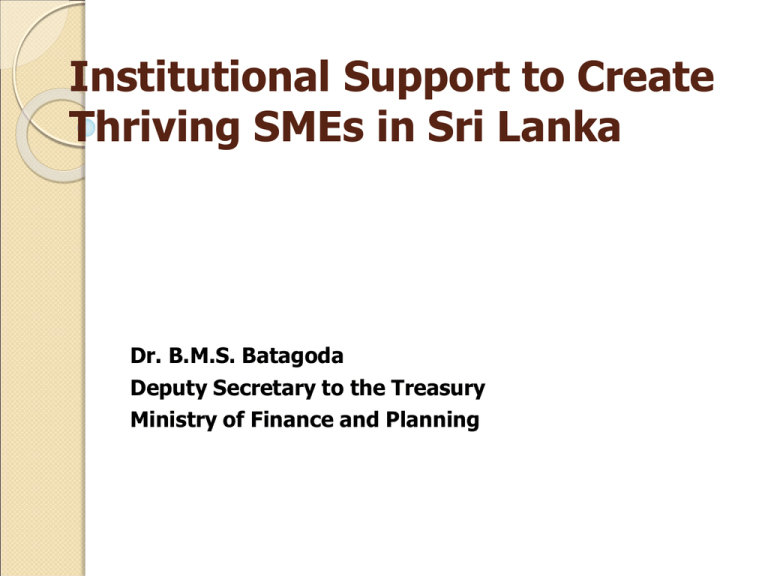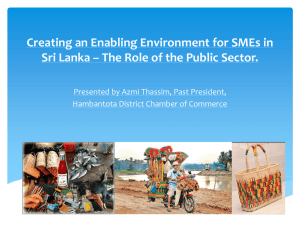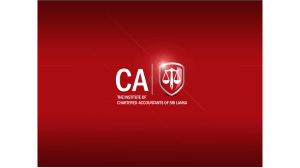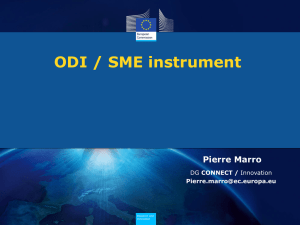Institutional Support to Create Thriving SMEs in Sri Lanka
advertisement

Institutional Support to Create Thriving SMEs in Sri Lanka Dr. B.M.S. Batagoda Deputy Secretary to the Treasury Ministry of Finance and Planning Sri Lankan Economy and Achievements since 2009 • After the end of 30 years long conflict situation prevailed in the country the ‘conflict country’ has now become a country with ‘emerging economy’ • The 2005 - 2010 period witnessed the ending of a 26 year long terrorist insurgency placing the country on a path of peace, reconciliation and rapid development. • Sri Lanka has emerged strongly as a middle income country with promising outlook. Sri Lankan Economy … Key Achievements Item Unit 2005 2010 2013 GDP USD bn 24.4 49.6 67.2 Per capita Income US$ 1,241 2,400 3,280 Inflation- GDP deflator % 5.7 7.3 6.7 Exports US$ bn 6.3 8.3 10.4 Unemployment % 7.2 4.9 4.4 Poverty % 15.2 7.6 6.4 Literacy Rate % 92.0 92.5 95.6 Literacy RateComputer % 9.7 20.3 40 Sri Lankan Economy … • • Impressive growth rate of 7.3 percent in 2013 recovering robustly from the lower growth rate of 3.5 percent recorded in 2009 Per capita income increased to US$ 3,280 in 2013 from US$ 2,057 in 2009 Sri Lankan Economy … Strong performance in all three sectors of agriculture, manufacturing and services • Share of GDP at Current Factor Prices from 1950-2013 70 60 40 Agriculture% Industry % 30 Services % 20 10 0 1950 1952 1954 1956 1958 1960 1962 1964 1966 1968 1970 1972 1974 1976 1978 1980 1982 1984 1986 1988 1990 1992 1994 1996 1998 2000 2002 2004 2006 2008 2010 2012 As a % 50 Year Sri Lankan Economy … • Low Inflation at 6.7 percent in 2013 • Overall budget deficit was reduced to 5.9 percent of GDP compared to the target the high deficit of 9.9 percent in 2009 • Unemployment rate declined to 4.4 percent in 2013 from 5.8 percent in 2009 Foreign Direct Investment -FDI FDI Inflow FDI FDI Inflow (as a Year (US$ % of Mn) GDP) 1,600 1,400 1,200 800 600 400 200 FDI Inflows 2013 2012 2011 2010 2009 2008 2007 2006 2005 2004 2003 2002 2001 2000 1999 1998 1997 1996 1995 1994 1993 1992 1991 - 1990 US$ mn 1,000 1990 42 0.52 1995 16 0.12 2000 173 1.04 2005 287 1.18 2010 516 1.04 2015 2500 2.5 2020 7500 4.0 Macro Fiscal Targets and Socio Economic Outcomes 2013 - 2016 Indicator GDP (Rs. Bn) Economic Growth Per Capita Income (US $) Inflation – GDP Deflator Budget Deficit as a % of GDP Total Government Debt as % of GDP Total Investment as a % of GDP Public Investment as a % of GDP Exports (US $ Bn) International Trade Turnover (US $ Bn) International Services Income (Net) (US $ Bn) Earnings from Tourism (US $ Bn) Remittances (US $ Bn) Access to Electricity Access to Telecommunication Women in Labor Force Unemployment Rate 2013 2014 2016 8,513 9,790 12,799 8% 9% 9% 3,638 4,171 5,394 5% 5% 5% 6% 5% 4% 78% 76% 75% 30% 31% 33% 7% 7% 7% 12 14 15 32 36 2 1 2 2 6 44 3 3 6 100% 100% 7 100% 93% 95% 100% 36% 37% 40% 4% 3.7% 3% Industry Related Key Targets by 2016 Increase Export Earnings Securing valuable foreign exchange to the country • Enhancement of potential export based industries to increase export earnings to US$ 15 billion • Saving US$ 3 billion per year by promoting import replacement industries Development of SME sector • Convert 5 percent of country’s SMEs to Medium Scale Industries in every year • Develop 5 percent of medium scale enterprises to large scale enterprises • Ensure proper access to finance • Make available affordable technologies for SMEs Key Development Strategies Create more conducive environment for investment Integrate into the Global economy through five hubs Empower the rural economy Diversification and growth of regional economies Urban -rural connectivity Revitalize the Agriculture sector Expand production, efficiency and quality of industries Globally competitive industrial sector Meeting energy needs of the country Knowledge-based economy Strategic reorientation of state owned enterprises (SOEs) Environmentally friendly urban development Sports Economy domestic Comparative Advantage - Sri Lanka A functioning democracy Environmental superiority Locational advantage (Hub-status) Promising Human resources / skilled labor Capacity to feed the rest of the world AAA Economy (Agriculture, Aquaculture, Animal-husbandry) Capacity to brand Sri Lanka - tea, natural rubber, spices, gem and jewelry,IT, bio-diversity and tourism, apparel (Contd…..) Comparative Advantage - Sri Lanka Potential heavy industries cement, steel, textile, sanitary-ware & ceramics Prospects in food industries sugar, dairy, agri- processing, value chain activities, food and beverages Health Economy- best regional Medicare clinical trials/ research/ pharmaceuticals Emerging knowledge-hub medical, legal, accountancy and finance expertise Asia’s best tourist destination eco- friendly, bio diversity, best beaches Significance of SMEs in Sri Lanka The Small and Medium Enterprises are the backbone and the engine of the growth. Some robust statistics indicating the significance of the SME sector EMPLOYMENT – 32 % by SMIs VALUE ADDED - 27 % by SMIs GDP Contribution Establishments - 52 % by SMEs - 80 % by SMEs 13 Significance of SMEs in Sri Lanka • The small-holders in the plantation industry account for 70 percent of total tea production of the country. • Similarly , 50 percent of the apparel and garment manufacturing is handled by individual entrepreneurs. • Over 70 percent of the public transportation sector is being dominated by individually owned bus and lorry operators. • About 80percent of domestic trade activities is done by sole proprietorships and partnerships. • Around 45 percent of tourism and recreation services are handled by family entrepreneurs. • At least 50 percent of the local construction industry is supported by small and medium enterprises. Export Performance of SMEs Number of Exporters ( %) Export Turnover (Rs.Mns) SME exporters 8% Large Exporters 10% SME exporters 90% Large Exporters 92% Key Elements for SME Development Ensuring proper access to finance Improving access to technology Improving access to market Facilitating backward forward linkages Maximum value addition and quality improvement Creating a skill labor force Simplified labor legislations and tax system Existing Institutional Support System for SMEs Public Sector Ministry of Finance & Planning Department of National Planning, Department of Development Finance Ministry of Economic Development Ministry of Technology and Research Industrial Technology Institute Ministry of Industry & Commerce National Enterprise Development Authority Ministry of Investment Promotion and -BOI Ministry of Traditional Industries & Small Enterprise Development Industrial Development Board, SMEA Ensuring Access to Finance Government implemented, is implementing several credit line projects to enhance the availability of the credit through existing banking network. 1. Donor Funded Projects • Small and Medium Industry I – IV project (SMI I-IV) - Status :- Completed - Project Duration :- 1979-1998 - Funding :- WB - $ 110 mn and ADB $45 mn - Total Loan Granted :- Rs. 7462.2 mn (15551 No of Loans) - Eligible Sectors :- 20 Sectors - Project Area :- Island wide - PFIs :- BOC,PB,HNB,DFCC, CB, NDB, SB,Seylan,RRDBs (Contd…..) Ensuring Access to Finance Small and Medium Sector Development Project (SMESDP) - Status :- Completed Project Duration :- 2002 – 2007 Total Loan Granted :- Rs. 5947.9mn (2020 No of Loans) Eligible Sectors :- 20 Sectors Project Area :- Island wide PFIs :- DFCC, CB, NDB, SB Small and Medium Enterprise Regional Development Project - Status :- Completed - Project Duration :- 2008 – 2011 - Total Loan Granted :- Rs. 4261.8 mn (966 No of Loans) - Interest rate :- Monthly AWDR + Operational cost + Margin - Eligible Sectors :- 21 Sectors - Project Area :- Out of Western Province - PFIs :- DFCC, CB, NDB, SB (SMERDP) (Contd…..) Ensuring Access to Finance • Small and Medium Enterprise Development Facility Project (SMEDeF) – WB funded Status :- On going Project Duration :- 2010 – 2015 Interest rate :- Average Monthly AWDR + 2% Eligible Sectors :- 23 Sectors Project Area :- Island wide PFIs :- BOC,PB,NHB,CB,NDB,SB,RDB,DFCC • EIB Loan Scheme – European Investment Bank Status – On going Project Area :- Island wide Project Duration – 2014-2015 Project Cost – Euro 90 mn PFIs – DFCC,CB,RDB (Conted…..) Ensuring Access to Finance • New Comprehensive Rural Credit Scheme - Status :- On going Project Duration :- 1994 – up to date Interest rate :- Farmer 8% (6% interest subsidy) Eligible Sectors :- 32 crops Project Area :- Island wide PFIs :- BOC,PB,NHB,CB,Seylan Bank,SB,RDB, (Conted…..) Ensuring Access to Finance 2. Local Funded Projects • Krushinavodaya Status :- Completed Project Duration :- 2007 – 2010 Interest rate :- 8 percent for borrower and 9 percent interest subsidy per annum Eligible Sectors :- Cultivation loans for Small farmers Project Area :- Island wide PFIs :- BOC,PB,NHB,CB,SDB,SB,RDB,LDB • Agro Livestock Development Loan Scheme (ALDL) Status :- Completed Project Duration :- 2008 – 2012 Interest rate :- Small dairy farmers 8% (6% interest subsidy) Investors 12 % (2% interest subsidy) Eligible Sectors :- Agriculture and Dairy farming, Livestock, milk processing Project Area :- Island wide PFIs :- BOC,PB,NHB,CB,NDB,SB,RDB,DFCC,SDB,UB (Contd…..) Ensuring Access to Finance Investment Fund Account (IFA) & SME Bank Branches • The steps were taken to establish an IFA by reducing tax on profit from 37 to 28 percent in each bank. • 10 percent out of IFA to be lent to each agriculture and SME sectors – Budget 2012 • setup a special SME bank branch by district under the Bank of Ceylon (BOC), People’s Bank (PB) and Regional Development Bank (RDB) – Budget 2012 Bank SME Branches IFA Balance Bank of Ceylon 12 6.9 billion People’s Bank 15 6.1 billion RDB SME unites were established in 633 million each regional office (Contd…..) Ensuring Access to Finance Loans granted by Sectors – 2013 Sector Total (Rs. mn) Amount Agriculture % 663.3 3.1 3,472.1 16.6 13,045.1 61.9 Hotels 2,470.0 11.7 Other 1,420.8 6.7 Total 21,071.3 100.0 SME Infrastructure Improving Access to Technology National Enterprise Development Authority (NEDA) was established Prime Objectives: Providing policy and institutional support to encourage promote and facilitate enterprise development within Sri Lanka (With special emphasis on the Small and Medium Enterprise Sector of the country). Stimulating the growth, expansion and development of Sri Lanka’s economy by encouraging, promoting and facilitating small and medium enterprise development within Sri Lanka. Formulate policies, plans, promotional incentives appropriately designed and effectively support and promote trade and development in industry, agriculture services. Empowerment of people of human capital development with technical skills as an integral component of enterprise development. Development infrastructure development needs. facilities required to make the (Contd…..) Facilitate the access to finances development and operations. to entrepreneurs for enterprise Establish a technology development fund to promote research and development, product development, technological enhancement and commercialization of patents. Facilitate regional economic development. Tax and related concessions Income tax was reduced to 10% Steps were taken to shield the sector from unfair import competition Steps were also taken to increase bank loans and reduce interest rates Propose to amend tax laws to permit SMEs, whose turnover does not exceed Rs. 500 million, to deduct expenditure of the year prior to the commencement of the enterprise, from the income of the first year in which tax become payable Small enterprise engaged in the collection of fresh milk, green tea leaves, cinnamon, latex will be exempted from Nation Building Tax (Contd…..) SMEs with a quarterly turnover of less than Rs. 500 million to be exempted from having to pay Economic Service Charge, up to Rs. 100 million Reduce taxes on the importation of machinery and equipment, where such items are not manufactured in Sri Lanka to promote the modernization of such factories Bank of Ceylon, Peoples Bank and Regional Development Bank will each set up a special SME bank branch in all districts Reduce prevailing income tax from 28% to 24% for the interest income from such banking and other fee levying activities (Contd…..) A 50% Government guarantee will be given for those banks providing loans to restructure SMEs to restructure their performance Increase the threshold income of the Economic Service Change for rs.25 million to Rs.50 million and thereby simplify the application of such tax. Ministry of Technology and Research provides their service to their service to the SME sector at a rate of 40%. The Ministry bares 60% of the cost of service regarding Research and development (Contd…..) Threshold for the registration for VAT Threshold of registration for VAT was increased by the VAT (Amendment) Act No.17 of 2013 with effective from 01.01.2013 from Rs.650,000/- per quarter or 2.5 million per 12 months to Rs.3 million per quarter or Rs. 12 million per 12 months. Accordingly SMEs with less than above threshold are not required register for VAT Similar amendment was introduced to NBT also 30 Thank You 31







